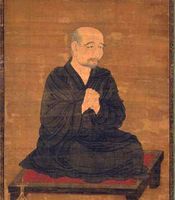Amoghavajra: Difference between revisions
No edit summary |
No edit summary |
||
| (12 intermediate revisions by 2 users not shown) | |||
| Line 1: | Line 1: | ||
{{Person | {{Person | ||
|HasDrlPage=Yes | |HasDrlPage=Yes | ||
|HasLibPage=Yes | |HasLibPage=Yes | ||
|HasBnwPage=Yes | |HasBnwPage=Yes | ||
|MainNamePhon=Amoghavajra | |MainNamePhon=Amoghavajra | ||
|SortName=Amoghavajra | |||
|MainNamePin=Bukong | |MainNamePin=Bukong | ||
|MainNameJapTranslit=Fukū | |MainNameJapTranslit=Fukū | ||
|MainNameKorTranslit=Pulgong | |MainNameKorTranslit=Pulgong | ||
|bio=Buddhist émigré ācarya who played a major role in the introduction and translation of seminal Buddhist texts belonging to the esoteric tradition or mijiao. His birthplace is uncertain, but many sources allude to his ties to Central Asia. Accompanying his teacher Vajrabodhi, Amoghavajra arrived in the Chinese capital of Chang'an in 720–1 and spent most of his career in that cosmopolitan city. In 741, following the death of his mentor, Amoghavajra made an excursion to India and Sri Lanka with the permission of the Tang-dynasty emperor and returned in 746 with new Buddhist texts, many of them esoteric scriptures. Amoghavajra's influence on the Tang court reached its peak when he was summoned by the emperor to construct an abhiṣeka, or consecration, altar on his behalf. Amoghavajra's activities in Chang'an were interrupted by the An Lushan rebellion (655–763), but after the rebellion was quelled, he returned to his work at the capital and established an inner chapel for homa rituals and abhiṣeka in the imperial palace. He was later honored by the emperor with the purple robe, the highest honor for a Buddhist monk and the rank of third degree. Along with Xuanzang, Amoghavajra was one of the most prolific translators and writers in the history of Chinese Buddhism. Among the many texts he translated into Chinese, especially important are the ''Sarvatathāgatasaṃgraha'' and the ''Bhadracarīpraṇidhāna''. (Source: "Amoghavajra." In ''The Princeton Dictionary of Buddhism'', 36. Princeton University Press, 2014. http://www.jstor.org/stable/j.ctt46n41q.27.) | |||
|PersonType=Authors of Chinese Works; Translators | |||
|images=File:Amoghavajra 14 century National Museum Tokyo Wikipedia.jpg{{!}}[https://en.wikipedia.org/wiki/Amoghavajra Amoghavajra, 14th century, National Museum, Tokyo] | |||
|YearBirth=705 | |YearBirth=705 | ||
|YearDeath=774 | |YearDeath=774 | ||
|StudentOf=Vajrabodhi | |StudentOf=Vajrabodhi | ||
| | |BuNayDefProvComplex=No | ||
|BuNayWheelTurnComplex=No | |||
|BuNayYogaMadhyaComplex=No | |||
|BuNayZhenRangComplex=No | |||
|BuNayVehiclesComplex=No | |||
|BuNayAnalyticMeditComplex=No | |||
|BuNayEmptyLuminComplex=No | |||
|IsInGyatsa=No | |IsInGyatsa=No | ||
|pagename=Amoghavajra | |||
}} | }} | ||
Latest revision as of 18:51, 19 August 2021
| PersonType | Category:Authors of Chinese Works Category:Translators |
|---|---|
| MainNamePhon | Amoghavajra |
| MainNamePin | Bukong |
| SortName | Amoghavajra |
| bio | Buddhist émigré ācarya who played a major role in the introduction and translation of seminal Buddhist texts belonging to the esoteric tradition or mijiao. His birthplace is uncertain, but many sources allude to his ties to Central Asia. Accompanying his teacher Vajrabodhi, Amoghavajra arrived in the Chinese capital of Chang'an in 720–1 and spent most of his career in that cosmopolitan city. In 741, following the death of his mentor, Amoghavajra made an excursion to India and Sri Lanka with the permission of the Tang-dynasty emperor and returned in 746 with new Buddhist texts, many of them esoteric scriptures. Amoghavajra's influence on the Tang court reached its peak when he was summoned by the emperor to construct an abhiṣeka, or consecration, altar on his behalf. Amoghavajra's activities in Chang'an were interrupted by the An Lushan rebellion (655–763), but after the rebellion was quelled, he returned to his work at the capital and established an inner chapel for homa rituals and abhiṣeka in the imperial palace. He was later honored by the emperor with the purple robe, the highest honor for a Buddhist monk and the rank of third degree. Along with Xuanzang, Amoghavajra was one of the most prolific translators and writers in the history of Chinese Buddhism. Among the many texts he translated into Chinese, especially important are the Sarvatathāgatasaṃgraha and the Bhadracarīpraṇidhāna. (Source: "Amoghavajra." In The Princeton Dictionary of Buddhism, 36. Princeton University Press, 2014. http://www.jstor.org/stable/j.ctt46n41q.27.) |
| YearBirth | 705 |
| YearDeath | 774 |
| StudentOf | Vajrabodhi |
| IsInGyatsa | No |
| Other wikis |
If the page does not yet exist on the remote wiki, you can paste the tag |

